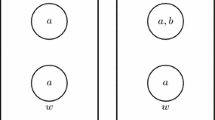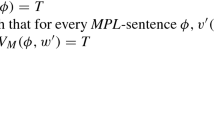Abstract
Two-dimensional semantics, which can represent the distinction between a priority and (one kind of) necessity, has wielded considerable influence in the philosophy of language. In this paper, I axiomatize the dagger (\(\dagger \)) operator of Stalnaker’s “Assertion” (1978) in the formal context of two-dimensional modal logic. The language contains modalities of actuality, necessity, and a priority, but is also able to represent diagonalization, a conceptually important operation in a variety of contexts, including models of the relative a priori and a posteriori often appealed to Bayesian and Gricean contexts. Finally, I sketch the prospects for extending this two-dimensional upgrade to other kinds of modal logics for natural language.





Similar content being viewed by others
Notes
It is worth noting, in this respect, that apriority (\({{\mathop {A}}}\)) can also be expressed via the compound “fixedly actually” (\({\mathcal {F}} @\)) operator discussed by Davies and Humberstone (1980). The semantic entry for \({\mathcal {F}}\) is:
- (\({\mathcal {F}}\)):
-
\({\mathcal {M}}, y, x \vDash {\mathcal {F}} \phi \) iff for all \(y'\): \({\mathcal {M}}, y', x \vDash \phi \)
The term diproposition comes from Humberstone (1981), whereas propositional concept is used by Stalnaker op. cit..
As is common in the literature, I will move freely between characterizing propositions as sets of possible worlds and as characteristic functions of those sets.
Because Crossley & Humberstone use ‘A’ for “actually” and ‘\(\square \)’ for our \(\blacksquare \), their version is called ‘(\(A5_\square \))’.
So-called because of their similarity to the frames in Restall (2012).
Conditions 1-2 on B-Restall frames are identical to Fritz’s (op. cit., pg 392), and the argument identical as well.
The mapping F from \({\mathcal {M}} = \langle W^X, R^X_@, R^X_\dagger , R^X_\blacksquare , V^X \rangle \) to \({\mathcal {R}} = \langle W, R_@, R_\dagger , R_\blacksquare , V \rangle \) is a bounded morphism if it satisfies the following conditions (Blackburn et al. 2002, pg. 59):
-
1.
w and F(w) satisfy the same proposition letters;
-
2.
if \(wR^X_\triangledown v\) then \(F(w) R_\triangledown F(v)\) (the Forth condition);
-
3.
if \(F(w) R_\triangledown v'\) then there exists some v s.t. \(wR^X_\triangledown v\) and \(F(v) = v'\) (the Back condition).
We can ensure that condition 1 is met for any valuation function V on \({\mathcal {R}}\) by ensuring that F(w) satisfies the same proposition-letters as w for any \(w \in W_{{\mathcal {R}}}\).
-
1.
References
Ahmed, Arif. (2014). Evidence, decision and causality. Cambridge: Cambridge University Press.
Åqvist, Lennart. (1973). Modal logic with subjunctive conditionals and dispositional predicates. Journal of Philosophical Logic, 2(1), 1–76.
Blackburn, P., de Rijke, M., & Yde, Venema. (2002). Modal logic. Cambridge: Cambridge University Press.
Blackburn, Patrick, & Marx, Maarten. (2002). Remarks on Gregory’s “Actually” operator. Journal of Philosophical Logic, 31, 281–288.
Burgess, John. (1999). Which modal logic is the right one? Notre Dame Journal of Formal Logic, 40, 81–93.
Chalmers, David. (2004). Epistemic two-dimensional semantics. Philosophical Studies, 118, 153–226.
Cresswell, M. (2012). Entities and indices (Vol. 41). Berlin: Springer.
Crossley, John, & Humberstone, Lloyd. (1977). The Logic of ‘actually. Reports on Mathematical Logic, 8, 11–29.
Davies, Martin, & Humberstone, Lloyd. (1980). Two notions of necessity. Philosophical Studies, 38(1), 1–30.
Elga, Adam. (2000). Self-locating belief and the sleeping beauty problem. Analysis, 60, 143–147.
Fritz, Peter. (2013). A logic for epistemic two-dimensional semantics. Synthese, 190, 1753–1770.
Fritz, Peter. (2014). What is the correct logic of necessity, actuality and apriority? Review of Symbolic Logic, 7(3), 385–414.
Fusco, Melissa. (2018). Epistemic time-bias in Newcomb’s problem. In A. Ahmed (Ed.), Newcomb’s problem. Cambridge: Cambridge University Press.
Fusco, Melissa. (2019). Naturalizing deontic logic: indeterminacy, diagonalization, and self-affirmation. Philosophical Perspectives, 32, 165–187.
Gregory, Dominic. (2001). Completeness and decidability results for some propositional modal logics containing actually operators. Journal of Philosophical Logic, 30(1), 57–78.
Hawthorne, J., & Magidor, O. (2009). Assertion, context, and epistemic accessibility. Mind, 118(470), 377.
Hazen, Allen, Rin, Benjamin, & Wehmeier, Kai. (2013). Actuality in propositional modal logic. Studia Logica, 101, 487–503.
Heim, I. (1982). The Semantics of definite and indefinite noun phrases. Ph.D. thesis, University of Massachusetts, Amherst.
Holliday, Wesley, Icard, Thomas, & Hoshi, Tomohiro. (2013). Information dynamics and uniform substitution. Synthese, 190(Suppl 1), 31–55.
Humberstone, Lloyd. (1981). Relative necessity revisited. Reports on Mathematical Logic, 13, 33–42.
Kaplan, David. (1989). Demonstratives. In J. Almog, J. Perry, & H. Wettstein (Eds.), Themes from Kaplan. Oxford: Oxford University Press.
Kripke, Saul. (1980). Naming and necessity. Cambridge: Harvard University Press.
Lampert, Fabio. (2018). Actuality, tableaux, and two-dimensional modal logics. Erkenntnis, 83, 403–433.
MacFarlane, John. (2009). Nonindexical contextualism. Synthese, 166, 231–50.
Magidor, Ofra. (2010). Review of Robert Stalnaker’s. Our Knowledge of the Internal World. Philosophical Review, 119(3), 384–391.
Restall, Greg. (2012). A cut-free sequent system for two-dimensional modal logic, and why it matters. Annals of Pure and Applied Logic, 163, 1611–1623.
Segerberg, Krister. (1973). Two-dimensional modal logic. Journal of Philosophical Logic, 2(1), 77–96.
Sider, Theodore. (2010). Logic for Philosophy. Oxford: Oxford University Press.
Smiley, Timothy. (1982). The schematic fallacy. Proceedings of the Aristotelian Society, 83, 1–17.
Stalnaker, R. (1978). “Assertion.” In Stalnaker (1999) (pp. 78–95). Oxford: Oxford University Press.
Stalnaker, Robert. (1999). Context and Content. Oxford: Oxford University Press.
Stalnaker, Robert. (2002). Common ground. Linguistics and Philosophy, 25(5–6), 701–721.
Stalnaker, Robert. (2010). Our Knowledge of the Internal World. Oxford: Oxford University Press.
Thomason, R. (1970). Indeterminist time and truth-value gaps. Theoria, 36(3), 264–281.
Williamson, Timothy. (2013). Modal Logic as Metaphysics. Oxford: Oxford University Press.
Wittgenstein, Ludwig. (1953). Philosophical Investigations. New Jersey: Wiley.
Wittgenstein, Ludwig. (1974). Tractatus logico-philosophicus. London: Routledge.
Author information
Authors and Affiliations
Corresponding author
Additional information
Publisher's Note
Springer Nature remains neutral with regard to jurisdictional claims in published maps and institutional affiliations.
This paper benefited from the input of many people. Warm thanks to Peter Fritz, Shawn Standefer, Thomas Icard, Lloyd Humberstone, Jarek Macnar, Michael Nielsen, Wes Holliday, Yifeng Ding, Sridhar Ramesh, Larry Moss, James Walsh, and especially Arc Kocurek.
Rights and permissions
About this article
Cite this article
Fusco, M. A two-dimensional logic for diagonalization and the a priori. Synthese 198, 8307–8322 (2021). https://doi.org/10.1007/s11229-020-02574-7
Received:
Accepted:
Published:
Issue Date:
DOI: https://doi.org/10.1007/s11229-020-02574-7




